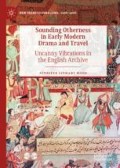Abstract
“Part II: Songs of the Orient” focuses on the sonic exchanges that occurred as travelers from England and Europe ventured eastward through the Ottoman Empire and India; Eastern sounds also featured in soundscapes constructed on the Renaissance English stage. Part II introduces the two chapters “An Organ’s Metamorphosis: Thomas Dallam’s Sonic Transformations in the Ottoman Empire” and “‘Drums Rumble Within’: Embodied Experiences of Temples in the East and on the London Stage.” Though the organ and the drum are not closely related acoustically, both demonstrate the haptic, tangible properties of the soundwave. “Songs of the Orient” echoes the title of a piece performed by Art Hickman’s orchestra—an uncanny blend of East and West, but one in which Western instruments are utilized to sound an Eastern otherness.
Access this chapter
Tax calculation will be finalised at checkout
Purchases are for personal use only
Notes
- 1.
This text is included in the collection Sir Francis Drake Revived (London, 1583), as the record of his second major voyage and circumnavigation of the globe. The title page states that this account was “Collected out of the Notes of Master Francis Fletcher, Preacher in this imployment, and compared with divers others Notes that went in the same Voyage.”
- 2.
Francis Drake Revived , 72.
- 3.
Francis Drake Revived , 88.
- 4.
Francis Drake Revived , 88.
- 5.
The more practical reason for firing cannons and other weapons was that empty chambers would not pose a threat, as reloading them would take time.
- 6.
Francis Drake Revived , 106.
- 7.
Francis Drake Revived , 107.
- 8.
Francis Drake Revived , 107.
- 9.
Writes Robert Jourdain, Music, the Brain, and Ecstasy: How Music Captures Our Imagination (New York: Harper Perennial, 1998), 92, “To be sure, there had long been reports of this exotic harmony. As early as 1580, Sir Francis Drake, afloat off the coast of Java, had described in his ships log a king of music ‘which thou it were of a very strange kind, yet the sound was pleasant and delightfull.’ But it would be three centuries before a European could comprehend gamelan music well enough to draw upon its ideas” like Debussy did. Jourdain states that Indian music can employ thirty-five different tuning systems, while the slendro scale of Indonesian gamelan varies slightly among different orchestras: “These discrepancies are intentional, allowing every gamelan orchestra to bring a unique harmonic personality to the stage, much as an actor brings his unique style to Hamlet” (76–77).
- 10.
William Prynne, Histrio-Mastix (London, 1632), 262.
- 11.
Jonathan Gil Harris, The First Firangis: Remarkable stories of Heroes, Healers, Charlatans, Courtesans & other Foreigners who Became Indian (New Delhi: Aleph Book Company, 2015), 5. Please refer also to Shankar Raman, Framing “ India ”: The Colonial Imaginary in Early Modern Culture (Stanford: Stanford University Press, 2001); Richmond Barbour, Before Orientalism: London ’s Theatre of the East, 1576–1626 (Cambridge: Cambridge University Press, 2003); Nabil Matar, Islam in Britain: 1558–1685 (Cambridge: Cambridge University Press, 1998); Nabil Matar, Turks , Moors , and Englishmen in the Age of Discovery (New York: Columbia University Press, 1999); Gerald MacLean and Nabil Matar, Britain and the Islamic World (Oxford: Oxford University Press, 2011).
Author information
Authors and Affiliations
Rights and permissions
Copyright information
© 2019 The Author(s)
About this chapter
Cite this chapter
Wood, J.L. (2019). Part II: Songs of the Orient. In: Sounding Otherness in Early Modern Drama and Travel. New Transculturalisms, 1400–1800. Palgrave Macmillan, Cham. https://doi.org/10.1007/978-3-030-12224-9_6
Download citation
DOI: https://doi.org/10.1007/978-3-030-12224-9_6
Published:
Publisher Name: Palgrave Macmillan, Cham
Print ISBN: 978-3-030-12223-2
Online ISBN: 978-3-030-12224-9
eBook Packages: HistoryHistory (R0)

